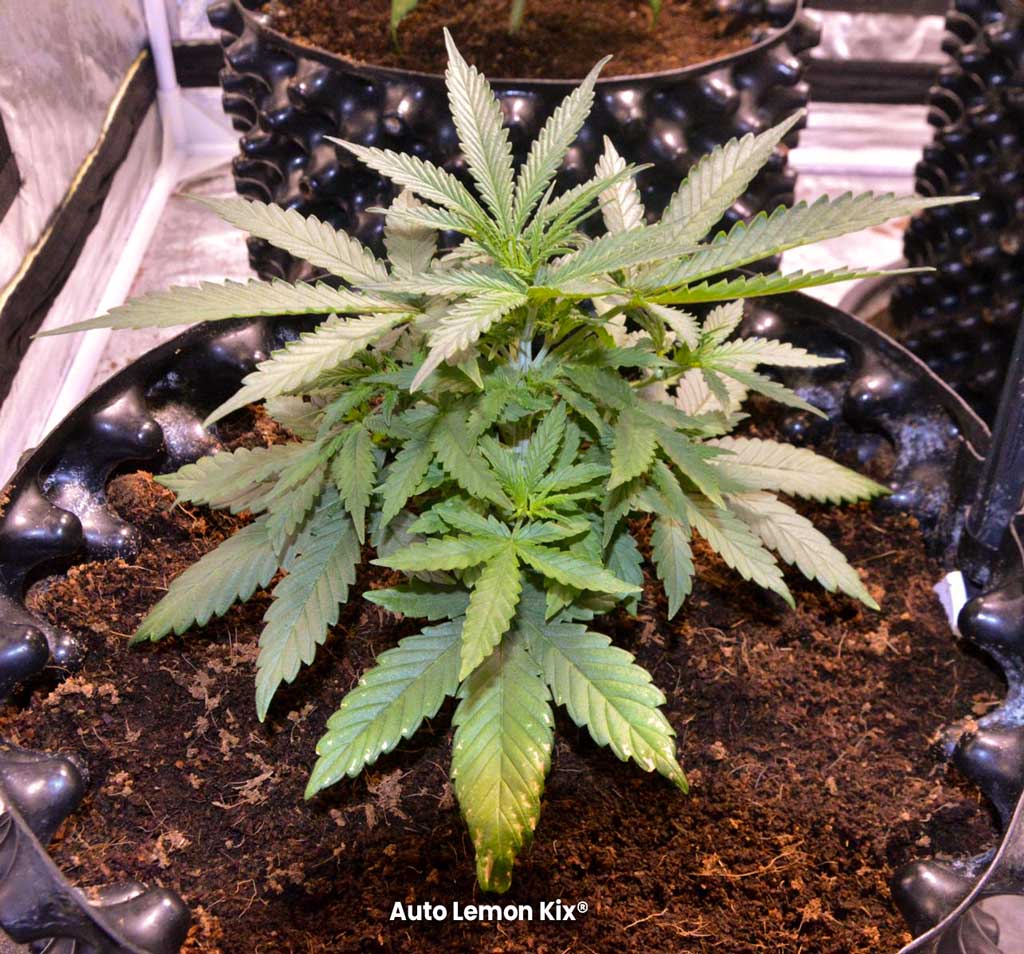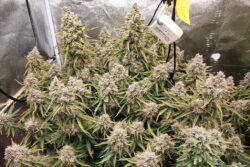Transplanting cannabis is the process of transferring the plant from one container to a larger one. Get it wrong and you can destroy the valuable root mass that has grown. Delay the transplanting too long and your plant can get root bound in its container. Some growers (especially those growing autoflower seeds) don’t bother with transplanting and germinate their cannabis seeds directly in the final container. So which is the best approach to transplanting when growing cannabis – frequent transplants or avoiding transplanting all together?
Transplanting cannabis: when & how to pot up?

Why is transplanting cannabis plants important?
Transplanting can be important because it introduces a larger volume of fresh grow medium to your plant. With a larger root mass, you can expect greater nutrient uptake and faster growth, with perhaps heavier final yields. Transplanting is all about trying to optimise the health of the cannabis root zone which should, in good conditions, mean heavier eventual harvests of top-quality buds.
Key factors to consider before you pot up your plants

Cannabis growers often tend to start their cannabis seeds in small containers and gradually transplant into larger containers as the plant grows. If you’re growing regular cannabis seeds you may prefer to transplant them into larger containers only after you have identified and removed the male plants. This may save space in your grow room.
So long as you are buying cannabis seeds from a reputable source you should expect 90%+ germination rates. So the days of needing to plant plenty of extra seeds, ‘just in case’, should be in the distant past. If not, it could be time to check out the best cannabis seed germination methods …or consider a new seed supplier.
One advantage of starting your seedlings in smaller containers is that you won’t need much initial space to grow them. That can be an important factor for some growers. It would allow you to get e.g. 5 seedlings in a small heated tray which could be illuminated by a small light (e.g. T5 or similar seedling light). Contrast that with 5 seedlings in 30 litre airpots which might require a 1.2m x 1.2m (4ft x 4ft) floor area to comfortably accommodate them.
Transplantation tactics will depend partly on the circumstances of the grower and the amount of available space they have. It’s worth saying that there are top quality growers that regularly transplant into increasingly large containers and get great results.
Conversely, other growers prefer the simplicity of getting the plants established in their final container and don’t bother with transplanting. They can also get great results. But there are some specific situations when it can be advantageous for the grower to embrace/avoid transplanting.
When and how to repot feminised photoperiod cannabis?

When growing photoperiod feminised cannabis seeds, many prefer to regularly transplant. Unlike autoflower seed cultivation, there is no ‘ticking clock’ dictating when the photoperiod plant must be finished by. This allows the grower to gradually increase the pot size as the plant ages, simply by keeping the plant in veg growth.
Avoid re-potting plants when the soil is dry and crumbly. This will result in an inefficient transplantation where you will inevitably lose some of the soil and roots. Instead ensure the soil has sufficient moisture so that it can retain its structure and shape when the container is removed. This ensures none of the valuable root mass is lost during the process.
Some growers add a sprinkling of mycorrhizal fungus powder to the new soil. This has a symbiotic relationship with the cannabis root system and can encourage new roots to take hold quickly. If you started with a light-mix soil for your germinated seedling you may wish to gradually increase the nutritional value of the future transplant soil to match the increasing demand for nutrients as your plant matures. This could mean that each new container of transplant soil benefits from a few extra amendments.
When growing feminised seeds, many prefer to avoid transplanting during flowering. This allows your plant to focus all her resources on the buds without the possible stress of transplantation (lost roots, damaged roots etc).
When and how to repot autoflower cannabis?

Autoflower seeds germinate and are often harvested around 11 weeks later. It’s an intensive but short life cycle with bloom happening ‘automatically’ around 4 weeks after germination. Because the cannabis genetics dictate a brief life cycle many autoflower growers prefer to start their cannabis seeds in the final grow container.
This avoids the potential loss of a few days growth due to e.g. a difficult transplant. That said, plenty of auto growers get great harvests by starting their seeds in small containers then carefully transplant to their final container after a couple of weeks.
One disadvantage of starting your autoflower seeds in their final containers is that you may not be able to light them all with a small light. That’s because the larger containers require more floor space and a larger light to illuminate them.
When growing autoflower seeds it is advisable to avoid transplanting during bloom.
Can you transplant cannabis multiple times?

Yes indeed. And many growers regularly take their time and transplant their cannabis plants several times. With a little practice, transplanting becomes easier without the disaster of a dry root ball crumbing into dust before your eyes. If in doubt, practice on some vegetable plants (or even garden weeds) to gain experience.
What is a root bound cannabis plant?
If a cannabis plant is kept in a container which is simply too small the roots run out of grow medium. You may see the roots ‘circling’ around the edges of the grow container, eventually tangling themselves into a tight mass. At this point, the plant has already lost some of its growth potential and will require effort to get it back on track. This may mean doing your best to manually untangle the roots before transplanting into a larger container with ample fresh nutritious new grow medium.
Growing cannabis in small containers generally results in smaller plants (and subsequent harvests) than may be possible in larger containers. Many home growers prefer to use a container with a minimum size of around 10 litres for bloom when growing in soil, coco clay pebbles or similar cannabis grow mediums. But as always, larger containers offer the potential for larger final plants/yields so long as conditions are good and no other rate-determining-factors limit growth.
Cannabis transplant stress-shock symptoms and cure

Like other plants, cannabis will experience stress and shock if environmental changes (including transplanting) are badly handled. A disruptive transplantation usually damages the root zone.
This leaves the plant temporarily unable to deliver the nutrition/water required for growth, and it may stop growing for several days as a result. During this time new roots will form and the grower is strongly advised to avoid intense light/heat levels until the cannabis plant has recovered.
Typical signs of transplant stress include:
- Weak new growth as the plant focusses biochemical efforts on root repair.
- Wilting even when watered (damaged root system is unable to transport enough fluid).
- Yellowing leaves.
- Reduced bud production, especially if the transplant was conducted during bloom.
- Leaves may drop from the plant.
- Nutrient sensitivity.
- Nutrient deficiency as the plant struggles to deliver essential minerals and nutrients.
Choose your cannabis seeds wisely!
The toughest cannabis genetics tend to have extra resilience, allowing them to cope well with plant stress arising from transplanting or other issues. You will be investing several months of time in your cannabis seeds. Select them wisely from a seed bank with a proven track record, a company you know has subjected all the strains to rigorous testing to eliminate stress-prone genetics. And enjoy your next grow!













2 Comments. Leave new
i would like to know when potting up can you bury the plant covering the cotyledons or even the first node? and when transplanting a seedling in a peat pellet why should the pellet stick out of the soil slightly?
Hi Sean,
The cotyledon leaves were evolved for photosynthesis. So normally, these are left above ground. We don’t have too much data about the effects of burying the cotyledons (or the first node), but logic suggests to keep them above ground. Peat pellets can dry out if they protrude too far above the surface, so the cautious grower tends to keep the peat pellet fairly level with the soil without too much protrusion. This helps more of the roots to emerge & grow in nutrient rich grow-medium.
I hope this helps!
Greetings,
MJ